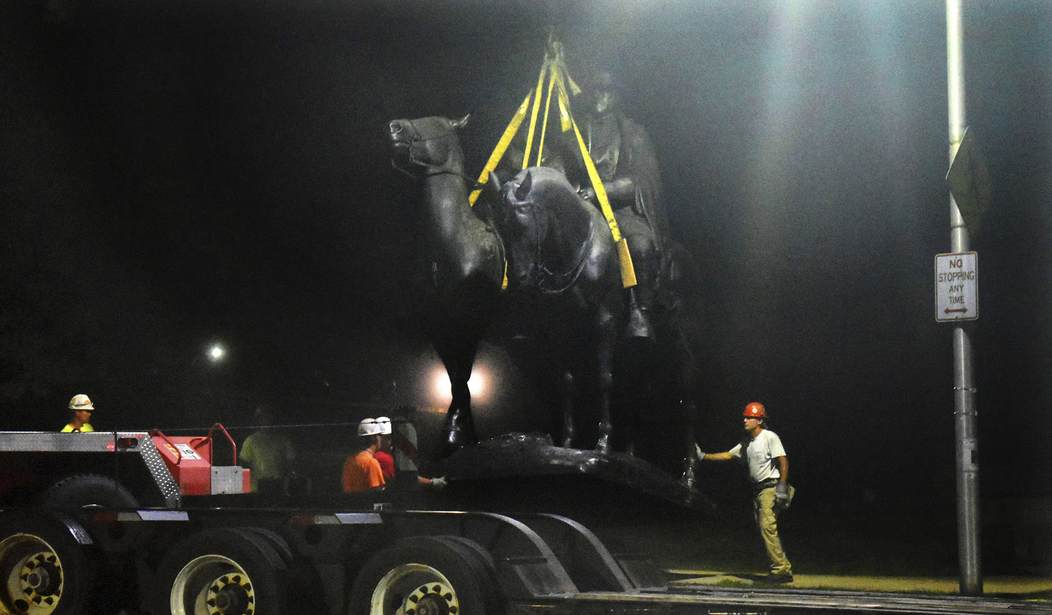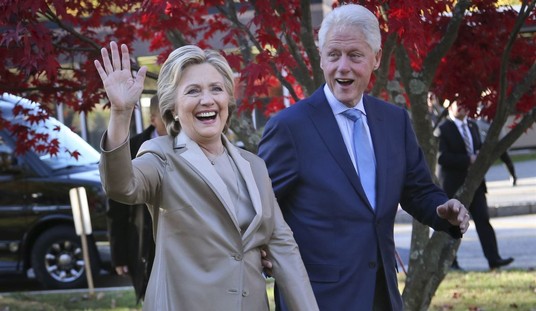In the wee hours of Wednesday morning, Baltimore removed its four Confederate monuments, including statues of Confederate Generals Robert E. Lee and Thomas J. “Stonewall” Jackson. This action followed this weekend’s events in Charlottesville, Va., when white supremacists protested the removal of a Lee statue, and events this week, when protesters vandalized Confederate statues in Durham, N.C., Louisville, Ky., and Gainesville, Fla.
Activists and government leaders are calling for more removals, while some counter protesters have organized to protect some monuments. Here is a brief summary of the monuments under attack — and those that aren’t.
Monuments removed.
The movement against Confederate symbols gained momentum two years ago after avowed white supremacist Dylann Roof murdered nine African-Americans at a church in Charleston, S.C. Roof had shared a picture of himself with the battle flag of the Army of Northern Virginia, known colloquially (if inaccurately) as the Confederate flag.
South Carolina legislators voted to remove the battle flag from Statehouse grounds, but they did not remove the memorial, which stands today.
In April, the Southern Poverty Law Center (SPLC) reported that “at least 60 … publicly funded symbols of the Confederacy have been removed or renamed” since 2015. Last year, the group documented more than 1,500 symbols of the Confederacy in public spaces. (The SPLC is also notorious for branding Christian organizations “anti-LGBT hate groups,” and even for inspiring terrorism against them, but on white supremacy, the group has more legitimacy.)
These 60 symbols seem to include restrictions on the battle flag, as the report pointed to universities and cities in Mississippi that refused to fly the state flag until it is redesigned. That list might also include Georgia’s decision to strike Confederate Memorial Day and Robert E. Lee’s birthday from the state’s holiday calendar. The SPLC report did not mention any monuments being removed, except those in New Orleans, La.
In April, the city of New Orleans began removing its four Confederate monuments, starting with the Battle of Liberty Place monument. The city removed three statues in the dark of night: the monument to the Battle of Liberty Place, the one commemorating Gen. P.T. Beauregard, and another commemorating Confederate President Jefferson Davis. In May, New Orleans removed the final statue, one of Gen. Lee, this time in daylight and to cheers.
As previously noted, Baltimore removed four monuments Wednesday morning. These included the Confederate Soldiers and Sailors Monument, the Confederate Women’s Monument, a monument to Supreme Court Justice Roger B. Taney, and a monument to Lee and Jackson.
Monuments threatened.
Last year, the SPLC reported that there are 718 Confederate monuments and statues, nearly 300 of which are in Georgia, Virginia, or North Carolina. That count has already fallen to 710, but after this past weekend’s events in Charlottesville, local leaders across the country have called for more removals.
Jim Gray, mayor of Lexington, Ky., announced on Saturday that he is “taking action to relocate the Confederate statues at the Historic Courthouse,” promising to ask the city council to petition the Kentucky Military Heritage Commission to remove them.
The statues in question commemorate Confederate General John Hunt Morgan and John C. Breckinridge, the 14th vice president of the U.S. who also served as Confederate secretary of war. The proposal Gray supported would move the statues to a city park, according to The Lexington Herald-Leader.
Construction workers removed a monument to Confederate soldiers known as “Old Joe” in Gainesville, Fla., on Monday.
On Monday, protesters at the Tennessee State Capitol in Nashville demanded the removal of a bust of Nathan Bedford Forrest, a Confederate general and Ku Klux Klan leader who was involved in a massacre of black soldiers in 1864.
Anna Lopez Brosche, president of the Jacksonville City Council in Florida, announced Monday that she is asking the city to take an inventory of all Confederate public symbols and to “develop an appropriate plan of action” to relocate them to museums. Brosche acknowledged that “part of the community” views the monuments as “part of our heritage,” but argued that another part of the community is triggered by them. These monuments evoke “some really negative emotions, and pain and hurt.”
In a Medium post on Tuesday, North Carolina Gov. Roy Cooper announced his plans to take down Confederate monuments. “Some people cling to the belief that the Civil War was fought over states’ rights. But history is not on their side,” Cooper wrote. “We cannot continue to glorify a war against the United States of America fought in the defense of slavery.”
Cooper argued that he must “protect North Carolinians and keep them safe,” and cited “the likelihood of protesters being injured or worse as they may try to topple” the monuments, and the danger of white supremacist rallies as in Charlottesville. His three-step plan involved repealing a 2015 law protecting Confederate monuments, examining the cost and logistics of removing them, and opposing a bill to protect drivers who strike protesters.
On Tuesday evening, Maryland Governor Larry Hogan called for the removal of a statue of Roger B. Taney, who wrote the Supreme Court’s opinion in the notorious Dred Scott v. Sandford case (1857), which instituted white supremacy and anti-black racism as the law of the land. After opposing the removal of monuments before, Hogan called for the removal to “avoid glorifying the darkest chapters of our history.”
On Wednesday, the Hollywood Forever Cemetery in Los Angeles, Calif. removed a memorial to Confederate veterans, the Los Angeles Times reported.
Also on Wednesday, the Dallas Observer reported that Mike Rawlings, mayor of Dallas, Texas, called for a task force to determine whether to keep the monuments, tear them down, or put them in a museum. The primary monument in Dallas is the Confederate War Memorial, a granite and marble monument commemorating a Confederate soldier, with statues of Robert E. Lee, Stonewall Jackson, General Albert Johnston, and President Jefferson Davis.
Monuments protected.
While the movement to remove Confederate monuments has ramped up, many counter protesters have organized to oppose their removal.
A group in Dallas has organized to protect the Confederate statues — and the group is mostly made up of African-Americans, CBS Dallas-Fort Worth reported Monday.
“I’m not intimidated by Robert E. Lee’s statue. I’m not intimidated by it. It doesn’t scare me,” former city council member Sandra Crenshaw explained. “We don’t want America to think that all African Americans are supportive of this.”
Crenshaw has teamed up with some members of the Buffalo Soldier historical re-enactment group and Sons of Confederate Veterans to protect Dallas monuments. “Some people think that by take a statue down, that’s going to erase racism,” Crenshaw explained. She dismissed this idea as “misguided.” She also defended the Freedman’s Cemetery as a Civil War monument that helps heal racial wounds.
Hillsborough County in Tampa, Fla., presented a fascinating approach to the entire issue. While county commissioners voted to remove the Confederate monument outside the historic Hillsborough County Courthouse, locals have organized to protect the monument from vandalism, Fox 13 News reported Tuesday.
Vandals targeted the memorial over the weekend, hitting it with red paint. Members of the local Sons of Confederate Veterans and other groups plan to stand guard from dawn until dusk, protecting it from further vandalism. “This is an American veterans monument and to disrespect this monument is to disrespect all veterans,” David McAllister, commander of the Sons of Confederate Veterans, argued.
In Delaware, Gov. John Carney attacked the presence of his state’s Confederate monument on Monday, but his spokesman clarified that because the monument is on private property, it cannot be removed. The monument includes a Northern Virginia battle flag and stands on private property in Georgetown.
“I think the Confederate flags that are flying across the South and different places like Georgetown misrepresent the history — they’ve been a way of rewriting the history since Civil War times and I think we ought to follow the lead of South Carolina and take them down,” Carney said. His spokesman Jonathan Starkey clarified that “Delawareans have a right to display flags on their private property, even in cases where those flags are offensive to most people.”
Perhaps the most important defense of Confederate monuments came on Tuesday from park officials at Gettysburg National Military Park. The park contains more than 1,325 monuments, markets, and plaques, reflecting how the July 1-3, 1863 battle has been remembered by different generations of Americans.
“These memorials, erected predominantly in the early and mid-20th century, are an important part of the cultural landscape,” park spokeswoman Katie Lawhon told USA Today in an email. Lawhon added that the park has not received any complaints about the monuments, nor any requests to remove them. The National Park Service is committed to safeguarding the site-specific monuments in perpetuity, she added.
Even if the majority of monuments across North Carolina, Virginia, and Georgia end up being removed, the site at Gettysburg will stand as a perpetual memorial to the valor of soldiers on both sides and the horrid scourge of the Civil War.
It is vitally important for Americans to remember their history. Indeed, the push to erase history has long been a tool of totalitarianism, so this movement should make liberty-loving Americans wary. Expect more announcements, and more protests, on both sides of this issue.









Join the conversation as a VIP Member